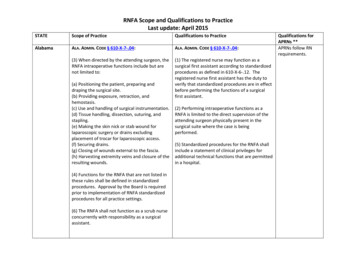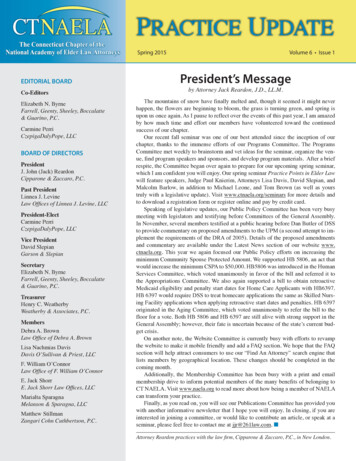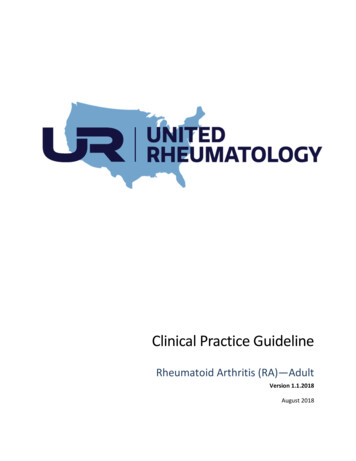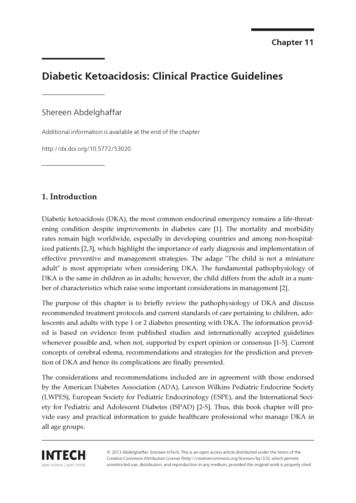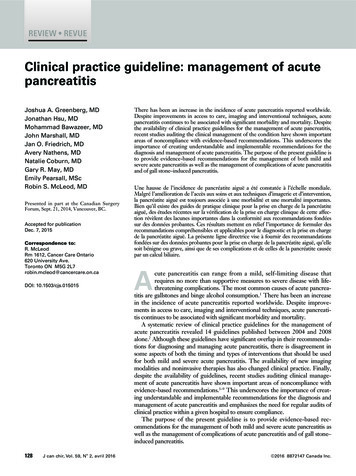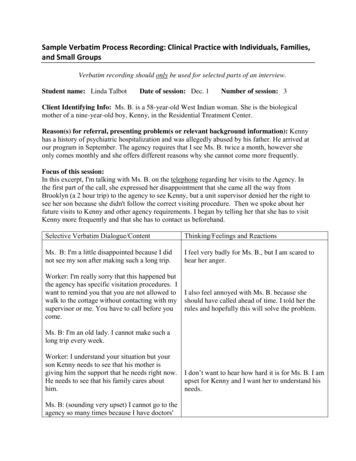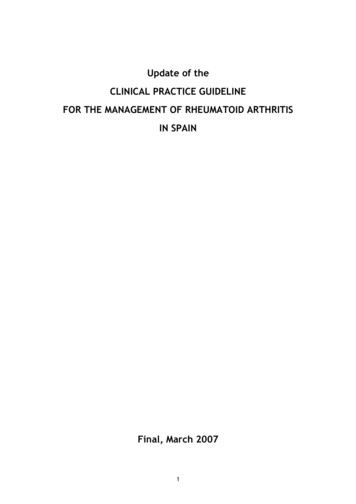
Transcription
Update of theCLINICAL PRACTICE GUIDELINEFOR THE MANAGEMENT OF RHEUMATOID ARTHRITISIN SPAINFinal, March 20071
Table of ContentsI. METHODOLOGY . 6Preliminary phase: Structure of GUIPCAR 2007 and task assignment . 6Review of the evidence . 7I.1.1. Summary . 7I.1.2. Review group of the Spanish Society of Rheumatology . 8I.1.3. Systematic reviews . 9I.1.4. Application of the reviews . 17Drafting the contents of GUIPCAR 2007 . 17Editing GUIPCAR 2007 . 18II. BACKGROUND . 23Importance of RA to the individual . 23Importance of RA to society . 23III. DIAGNOSIS . 25Suspected RA . 25III.1.1. Importance of early diagnosis in RA. 25III.1.2. Detection of RA in Primary Care . 25Access to the rheumatologist . 27III.1.3. Recent-onset arthritis units . 27III.1.4. Organization of the consult in its interaction with primary care . 28Diagnosis of rheumatoid arthritis . 29III.1.5. 1987 ACR classification criteria . 29III.1.6. Diagnostic utility of biological tests in recent-onset RA . 32III.1.7. Proposals of new diagnostic criteria for recent-onset arthritis . 34IV. EVALUATION . 37Specific RA evaluation . 37IV.1.1. Appropriate data for first evaluation of RA patient . 37IV.1.2. Data common to the initial evaluation and follow-up of RA . 38Treatment evaluation . 54IV.1.3. Objective of RA treatment . 54IV.1.4. Treatment-response criteria . 54IV.1.5. Frequency of check-ups . 56IV.1.6. Nursing consultations . 57RA comorbidity . 60IV.1.7. RA complications . 61IV.1.8. Comorbidity not directly related with RA. 70V. PHARMACOLOGICAL TREATMENT . 82Pharmacological treatment of recent-onset rheumatoid arthritis. . 83V.1.1. Disease-modifying anti-rheumatic drugs: dosage and commercial names . 872
V.1.2. Evidence tables . 90Changes in treatment . 103Treatment with glucocorticoids . 107Treatment with non-steroidal anti-inflammatories (NSAIDs) . 111Treatment for pain . 113Treatment of RA in special situations . 114V.1.3. Elderly patients. 114V.1.4. Pregnancy and breastfeeding . 115VI. SAFETY OF PHARMACOLOGICAL TREATMENT . 119Antimalarials: chloroquine (CLQ) and hydroxychloroquine (HCQ) . 119Anti-TNFs: Infliximab (IFX), Etanercept (ETN), Adalimumab (ADA) . 120VI.1.1. Adverse effects of the anti -TNFs . 121VI.1.2. Monitoring the anti-TNFs. 126VI.1.3. Contraindications of the anti-TNFs. 127Azathioprine (AZT) . 127VI.1.4. Adverse effects of azathioprine . 127VI.1.5. Monitoring azathioprine . 128Cyclophosphamide (CTX) . 128VI.1.6. Adverse effects of cyclophosphamide . 129Cyclosporin A (CSA) . 131VI.1.7. Adverse effects of cyclosporin A . 131D-penicillamine (DPC) . 132VI.1.8. Adverse effects of D-penicillamine . 132Leflunomide (LEF) . 133VI.1.9. Adverse effects of leflunomide . 134Methotrexate (MTX) . 135VI.1.10. Adverse effects of methotrexate . 136Gold salts: oral (AUR) and injectable (IG) . 138VI.1.11. Adverse effects of gold salts . 139Sulfasalazine (SSZ) . 140VI.1.12. Adverse reactions to sulfasalazine . 140Anakinra (ANK) . 142VI.1.13. Adverse effects of anakinra . 142Abatacept (ABT) . 143VI.1.14. Adverse effects of abatacept . 143VI.1.15. Contraindications . 143Rituximab (RTX) . 144VI.1.16. Adverse effects of rituximab . 144VI.1.17. Monitoring . 145VI.1.18. Contraindications . 1453
VII. OTHER TREATMENTS . 151Intra-articular treatment . 151VII.1.1. Indications . 151VII.1.2. Types of intra-articular treatment . 151Rehabilitation in rheumatoid arthritis . 152VII.1.3. Introduction . 152VII.1.4. Non-pharmacological interventions . 152Surgical treatment in RA* . 164VIII. MANAGEMENT . 166Indicators based on time . 167Indicators based on percentages . 168VIII.1.1. Early detection . 168VIII.1.2. DMARD treatment in window of opportunity . 168VIII.1.3. Patient visits for recent-onset RA . 168VIII.1.4. Patient visits for established RA in complete remission . 169VIII.1.5. Percentage of patients with DMARD treatment . 169VIII.1.6. Use of orthopedic surgery . 169VIII.1.7. Losses to follow-up . 170VIII.1.8. Remission. 170IX. APPENDICES . 171Data collection instruments for parameters used in initial evaluation and monitoring of RApatients . 171Joint counts . 177ACRONYMS . 178REFERENCES . 180REFERENCES OF STUDIES INCLUDED IN THE SYNTHESIS OF THE EVIDENCE . 284X. PARTICIPANTS . 294Expert panel . 294Coordinators . 296Reviewers . 297Conflicts of interest . 2994
INDEX TO TABLESTable 1. Levels of Evidence. Oxford Centre for Evidence-Based Medicine (May 2001) . 19Table 2. Explanatory notes for table 1 . 21Table 3. Grades of recommendation . 22Table 4. Criteria for referral of recent-onset arthritis to Specialty Care . 26Table 5. ACR classification criteria for rheumatoid arthritis (1987) . 30Table 6. Comparative performance of the 1987 ACR criteria in patients with established RA,according to recent studies . 30Table 7. Performance of the 1987 ACR criteria in different studies of patients with recentonset RA. . 31Table 8. Classification of synovial fluid according to composition . 32Table 9. Value of each criterion in predicting different outcomes, according to Visser et al. 35Table 10.
Diagnosis of rheumatoid arthritis . 29 III.1.5. 1987 ACR classification criteria . 29 III.1.6. Diagnostic utility of biological tests in recent-onset RA . 32 III.1.7. Proposals of new diagnostic criteria for recent-onset arthritis . 34 IV. EVALUATION . 37 Specific RA evaluation . 37 IV.1.1. Appropriate data for first evaluation of RA patient . 37 IV.1.2. Data common .





